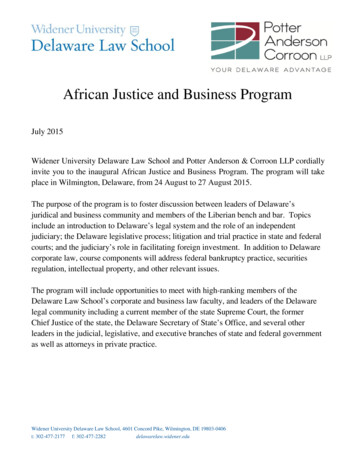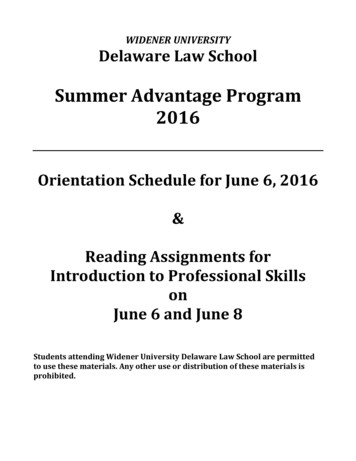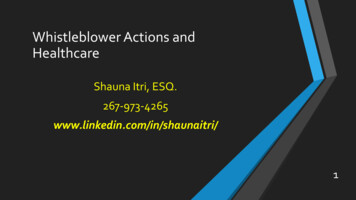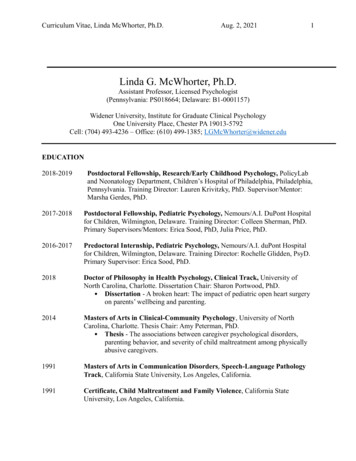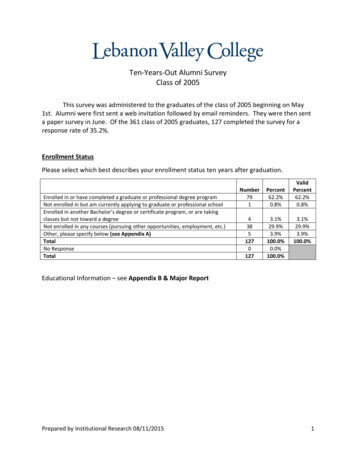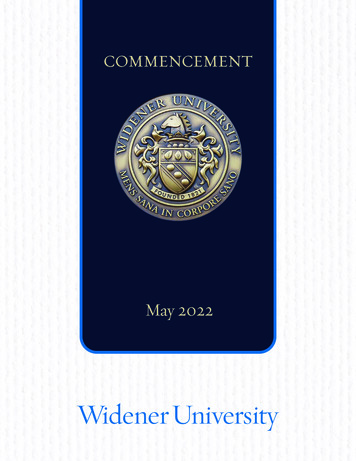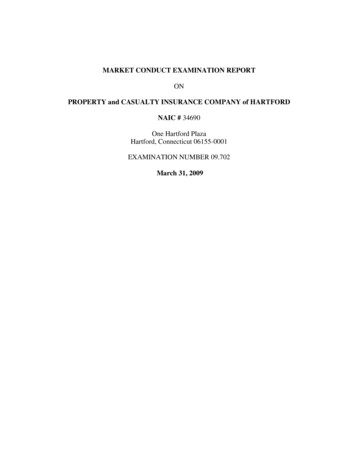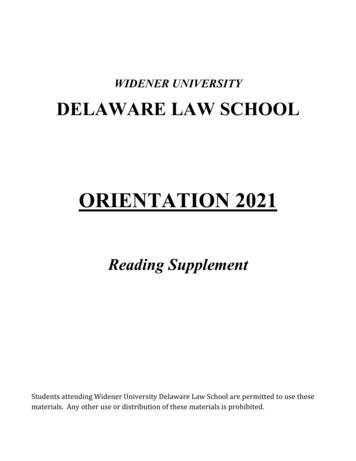
Transcription
WIDENER UNIVERSITYDELAWARE LAW SCHOOLORIENTATION 2021Reading SupplementStudents attending Widener University Delaware Law School are permitted to use thesematerials. Any other use or distribution of these materials is prohibited.
Directions: You should read this supplement prior to the second day of Orientation and be prepared todiscuss the three cases that appear later in this packet (pp 17 – 28). Some of this material willsupplement or reinforce the topics covered in the Harvard Zero-L online program. Other material willintroduce you to additional legal analysis skills that you’ll find important for your success in law school,including how to outline and how to effectively answer law school essay exams.SECTION IINTRODUCTIONFor a number of reasons, law school likely will be a new and unique experience in professionaleducation for you. You may not have heard of some of the subject matters you will address, andthe vocabulary you will be asked to use may seem alien. For example, what is a tort if not adessert? Or, what is offensive, non-mutual collateral estoppel, and – more importantly – why wouldanyone care about it? In addition, the workload in law school is heavy. A common assumption is astudent should spend at least two to three hours preparing for each hour of class time. Even thetesting and grading processes in law school are often different from such processes in otherschools.Given the singular aspects of a law school education, the Orientation program will help you beginto develop the skills necessary to address the unique features of a law school education. TheOrientation program provides a common body of knowledge for all students in the first semester.The program also provides opportunities to discuss and practice some of the skills essential tosuccess as a law student and as a member of the legal profession.You may get confused, frustrated, and intimidated in developing your understanding of the law.Don’t give up! In fact you are not permitted to give up, and here is the reason why. As Dean Smollawill further explain in the opening session of Orientation, every state has a professional code ofethics governing those admitted to the legal profession in the state. Those codes identify diligenceand competence as fundamental traits of the profession. 1 Professional diligence requires a lawyer“to pursue a matter . . . despite opposition, obstruction, or personal inconvenience . . . .” 2Competence requires knowledge of the law and skill in using that knowledge. Orientation is yourfirst step toward professional competence and diligence. You can do this. Here we go!.1For example, Rule 1.1 of the American Bar Association’s Model Rules of Professional Conduct provides: “A lawyer shall providecompetent representation to a client. Competent representation requires the legal knowledge, skill, thoroughness and preparationreasonably necessary for the representation.” Model Rule 1.3 provides: “A lawyer shall act with reasonable diligence andpromptness in representing a client.” Most States have used the ABA’s Model Rules as a template.2Model Rule of Prof’l Conduct R. 1.3, Comment 1 (2015).1
SECTION IICHARACTER & FITNESS REQUIREMENTS OF THE PROFESSIONa. Before Admission to the BarWhile you now know that professional codes of ethics regulate the professional conduct oflawyers, it may surprise you to learn that conduct when you are not acting as a lawyer also will besubject to professional regulation. Your conduct before law school and while in law school issubject to scrutiny by the profession. For example, you may recall the application for admission toDelaware Law includes these questions:13. Character & Fitness1. Have you ever received an academic warning, been placed on probation, disciplined,suspended or dismissed by any learning institution or licensing board for any reason? If“Yes,” you must use an electronic attachment to provide your detailed explanation. Yourexplanation must include the nature of the event/offense, the underlying facts and allrelevant dates. Without this information, your application will remain incomplete andineligible for review and decision. Note: You have a continuing duty to update theinformation you provided in response to this question. You must notify Delaware Law of anyacademic or disciplinary actions occurring after submission of this application.2. Have you ever been arrested, taken into custody, or accused formally or informally ofthe violation of a law for any offense other than a minor traffic violation? If “Yes,” you mustuse an electronic attachment to provide your detailed explanation. Your explanation mustinclude the nature of the offense, the facts surrounding the offense, all relevant dates,dispositions and sanctions. If currently on probation or parole, you must provide all termsand conditions. Please note any instance of driving under the influence, and offenses whichhave been expunged or occurred while a juvenile, including disorderly persons’ offenses.Note: You have a continuing duty to update the information you provided in response to thisquestion. You must notify Delaware Law of any legal violations occurring after submissionof this application.The application also provides:Any false or misleading statement, incomplete or inaccurate information, omissions ofrequired information or failure to update changes in information in this application maycause you to be denied admission; OR, if admitted, to be dismissed from the School of Law orcause your degree to be revoked by the dean, and may jeopardize licensure with the Boardsof Bar Examiners.Law schools inquire about “character and fitness,” in part to prepare you for the review of yourcharacter and fitness that will occur again upon your successful completion of law school andbefore admission to practice. Not only must an applicant to a state bar pass a multi-day barexamination, the applicant also must pass a review by the board of bar examiners of theapplicant’s character and fitness. You also should note that boards of bar examiners often2
compare the responses a bar applicant gave to the character and fitness questions on law schoolapplications with responses to similar questions on applications for admission to the bar. Anydiscrepancy in the two sets of responses may adversely affect an applicant’s admission to practice.For this reason, the law school will provide you with the opportunity to update your law schoolapplication in the coming weeks to include any relevant incidents that were not previouslydisclosed. (This will be addressed during the Character and Fitness session of Orientation.)The boards of bar examiners in most states have web sites with information about therequirements for admission to the profession in the particular state. We encourage you tofamiliarize yourself now with the standards for character and fitness published by the examinersof the states in which you may seek admission to practice. Please also note the scope of theinquiry by a board of bar examiners may be broader than the inquiries about character and fitnesson a law school application.You will find that many states use similar language to describe the requirements of character andfitness. Below (in italics) you will find excerpts from the website of The Pennsylvania Board ofLaw Examiners that exemplify common concerns and objectives.What are the character and fitness standards?The character and fitness standards require that an applicant to the bar be one whose record of conductjustifies the trust of clients, adversaries, courts and others. The hallmark of such a person is honesty, especiallyin connection with the application for admission to the bar. Persons with a record showing a deficiency inhonesty, trustworthiness, diligence or reliability may not be recommended for admission.[The website for the Pennsylvania Board of Law Examiners contains the following examples ofdeficient conduct that will lead the Board to investigate an applicant before recommending anapplicant’s admission]: unlawful conductacademic misconductemployment misconductmaking false statement(s), including the omission of relevant factsacts involving dishonesty, fraud, deceit or misrepresentationabuse of the legal processneglect of financial responsibilities, especially failure to repay student loansneglect of professional obligationsviolation of an order of a courtevidence of mental or emotional instability, as it relates to the ability to practice lawevidence of current or recent dependency on a substance such as alcohol, a narcotic, an illicit drug, or amood-altering substance, or evidence of current or recent abuse of such a substance or a prescriptiondrugdenial of admission to the bar in another jurisdiction on character and fitness groundsdisciplinary action by a lawyer disciplinary agency or other professional disciplinary agency3
What is the most common reason for denial of a bar applicant?A pattern of dishonesty in dealings with employers, schools, and authorities, including the Board, is a commonreason for denial of bar applicants. Giving false information on the application or failing to be completelycandid in the application process is a serious issue, which will have negative consequences for an applicant.The failure to be fully responsive to application questions, or any other lack of candor in an application,involves unsworn statements made to an agency of the Supreme Court. Since this dishonesty would be bothcurrent and ongoing, the applicant charged would have a difficult time demonstrating rehabilitation.Do I have to disclose [criminal] incidents from when I was a juvenile or those that were expunged?You must disclose each criminal incident where you were arrested, charged, cited, accused or prosecuted forany crime, even if: the charges were dismissed; or you were acquitted or pardoned; or adjudication waswithheld; or a conviction was reversed, set aside or vacated; or the record was sealed or expunged; or youentered some type of diversionary program, such as A.R.D. You must disclose each incident, regardless ofwhether you believe or were told that you need not disclose it.Why does the Board inquire about misdemeanor or felony arrests which did not result inconvictions?There are many reasons why arrests do not result in convictions, many of which have no bearing on guilt orinnocence. Applicants are required to report all incidents, and to provide evidence of rehabilitation andcurrent good character. The occurrence of an acquittal or dismissal is relevant but not dispositive of the issue.This is not to suggest that the Board will assume that any arrest was due to guilty conduct on the part of theapplicant. The applicant's obligation is to be completely candid regarding all matters about which the Boardinquires.b. After Admission to the BarEven after admission to a bar, certain rules of professional ethics apply to a lawyer’s personal life.So, for example, Rule 8.4 of the Rules of Professional Conduct adopted by the Delaware SupremeCourt provides, in part:Maintaining the Integrity of the ProfessionRule 8.4 MisconductIt is professional misconduct for a lawyer to:***(b) commit a criminal act that reflects adversely on the lawyer’s honesty, trustworthiness or fitness as alawyer in other respects;(c) engage in conduct involving dishonesty, fraud, deceit or misrepresentation;(d) engage in conduct that is prejudicial to the administration of justice;***4
COMMENT [to Model Rule of Professional Conduct 8.4]***[2] [With regard to (b) above] Many kinds of illegal conduct reflect adversely on fitness to practice law, such asoffenses involving fraud and the offense of willful failure to file an income tax return. . . . Offenses involvingviolence, dishonesty, breach of trust, or serious interference with the administration of justice are in thatcategory. A pattern of repeated offenses, even ones of minor significance when considered separately, canindicate indifference to legal obligation.[3] A lawyer who, in the course of representing a client, knowingly manifests by words or conduct, bias orprejudice based upon race, sex, religion, national origin, disability, age, sexual orientation or socioeconomicstatus, violates paragraph (d) when such actions are prejudicial to the administration of justice. Legitimateadvocacy respecting the foregoing factors does not violate paragraph (d). * * *[5] Lawyers holding public office assume legal responsibilities going beyond those of other citizens. A lawyer’sabuse of public office can suggest an inability to fulfill the professional role of lawyers. The same is true ofabuse of positions of private trust such as trustee, executor, administrator, guardian, agent and officer,director or manager of a corporation or other organization.* * * *SECTION IIICOMMON ELEMENTS OF A CIVIL LAWSUITMuch of the assigned reading in your first semester will describe issues arising in the context ofcivil litigation. It is useful to have a basic understanding now of common elements of a civillawsuit. Below are brief descriptions of those elements and a summary in two charts, which willreinforce and supplement what you learned in Zero-L. 3a. InvestigationCourts seek to provide just resolutions of disputes, but courts do not want to waste resources onfrivolous litigation. More than a good story is necessary to begin a lawsuit. There must be afactual basis for the story and the facts must be relevant to a right or obligation arising from somelaw. Lawyers representing potential claimants must reasonably investigate the facts and the lawbefore filing suit on behalf of a client. The same practical duties of investigation apply todefendants before responding to a claim.3 In your Civil Procedure course you will discuss in greater detail how a civil lawsuit begins and may progress.5
b. Choice of Forum LimitsAlthough there are numerous trial courts throughout the United States from which a plaintiffmight pick, 4 the authority of a particular court to render a valid judgment depends on whether thecourt has jurisdiction over the subject matter and jurisdiction over the defendant. Even if those tworequirements are met, a particular court may not be considered an appropriate venue within aState containing multiple courts in the same court system. As you will learn, the issues ofjurisdiction and venue are complicated topics. It suffices for now that you understand there aremultiple factors affecting a plaintiff’s choice of a court (forum) capable of rendering a validjudgment.c. PleadingsTo begin a civil lawsuit in federal court and in many state courts, the plaintiff files a documentcalled a complaint with the court and serves a copy of the complaint on the person or entity againstwhich the plaintiff is making the claim – the defendant. The complaint sets forth the bases forsubject matter jurisdiction, describes the plaintiff's loss, explains how the defendant caused theloss, and asks the court to order a remedy. A plaintiff may ask a court to order a variety ofremedies, such as money from the defendant to compensate for the plaintiff’s loss or a prohibitionon the defendant’s conduct causing the plaintiff’s loss. The court also may also order other typesof relief, such as a declaration of the legal rights of the plaintiff in a particular situation. 5After being served with the complaint, a defendant has an opportunity to respond to thecomplaint. A defendant can file a motion (a request for a court to issue an order) asking the courtto dismiss the plaintiff’s claims for a variety of reasons, such as lack of jurisdiction over thedefendant or over the subject matter. A defendant also may choose to respond directly to thespecific allegations in the complaint by filing a pleading in which the defendant admits or deniesthe plaintiff’s allegations and asserts other reasons for which the plaintiff would not recover underthe applicable law. If a defendant fails to respond to the complaint – or responds in a mannerdeemed inadequate by the court – a default judgment can be entered in favor of the plaintiff.d. Case ManagementJudges seldom follow the tradition of acting merely as neutral referees in the pretrial portions ofcivil litigation. Rather, judges often foster efficient management of the dispute resolution processby conferring with the parties shortly after the pleading stage to formulate a plan and a timelinefor subsequent parts of the pretrial process. A judge also can use case management conferences tofoster settlement discussions among the parties to a lawsuit. If a trial will be necessary to resolvea dispute, case management frequently includes a conference of the judge and the parties to set a4 For a general description of federal and state court systems, see Tracey E. George & Suzanna Sherry, What Every Law StudentReally Needs to Know: An Introduction to the Study of Law, 86-95 (2016).5 For a summary of damages and injunctions as remedies a court might order, see Tracey E. George & Suzanna Sherry, What EveryLaw Student Really Needs to Know: An Introduction to the Study of Law, 97-99 (2016).6
plan for the trial.e. DiscoveryDiscovery is an opportunity for parties to a lawsuit to collect from each other and from non-partiesinformation relevant to the claims and defenses raised in the suit. Rules of procedure provide anumber of different methods for collecting the information, such as depositions, documentrequests, interrogatories, physical examinations and requests for admissions. Courts haveauthority to sanction parties and non-parties who fail to comply with proper discovery requests.f. Dispositive Motions Later in the Pretrial ProcessTrials do not occur in most civil litigation, because settlements negotiated by the parties ordispositive pretrial motions resolve most lawsuits. A motion for summary judgment is one suchpretrial motion. The party making the motion asserts that the court has enough information toconclude there cannot be a rational dispute about the facts giving rise to a claim (or defense) inthe lawsuit and the applicable law entitles the moving party (the party making the motion) to ajudgment in its favor given those facts. The moving party seeks to convince the court there is noneed to proceed further with a claim.g. TrialIf a trial is necessary to resolve civil litigation, constitutions and statutes may afford the right to ajury trial for some claims. At trial the parties must address the burden(s) of proof applicable attrial. 6 The plaintiff presents evidence of its version of the facts supporting its claims, and thedefendant presents evidence rebutting the plaintiff's evidence or supporting its own version of thefacts. From the evidence presented, the jury must decide what happened (the underlying facts)and render a verdict after applying to the facts the applicable law as described by the judge. Thejudge will enter a judgment after the jury’s verdict. If there is no right to a jury trial for aparticular claim or if a party waives its right to a jury trial, then the judge becomes the fact finderand applies the applicable law to the facts.During trial and after entry of judgment, a party may make a motion for a judgment as a matter oflaw. The motion for a judgment as a matter of law and the pretrial motion for summary judgmentdescribed above are similar in that the party making the motion asserts a rational decision makermust find in the moving party’s favor based on the information available to the court at the time ofthe motion. The motion for judgment as a matter of law and the motion for summary judgmentdiffer, however, in two significant ways. First, a motion for judgment as a matter of law can bemade only after the non-moving party has had its opportunity to be heard at trial. Second, themotion for judgment as a matter of law focuses on what a rational decision maker could concludefrom the information admitted into evidence at trial before a party makes the motion.6 For a summary of the burden(s) of proof at trial, see Tracey E. George & Suzanna Sherry, What Every Law Student Really Needsto Know: An Introduction to the Study of Law, 116-118 (2016).7
A party dissatisfied with a trial judgment also can make a motion in the trial court for a new trial.There are a variety of reasons for which a trial court could grant a new trial. What is important tounderstand at this point is how a motion for a new trial differs from a motion for judgment as amatter of law. The latter motion requests the court to enter judgment in favor of the movingparty, i.e., to pick a winner. The motion for a new trial requests only another chance at a trial.h. AppealA party that is dissatisfied with an outcome in the court in which a suit commences -- often calledthe trial court or court of original jurisdiction – may ask a court of appeals to review trial courtproceedings for errors. An appellate court may be an intermediate appellate court with theauthority to review trial court proceedings but which also is subject to review by a final or highestappellate court in the particular court system. The jurisdiction of appellate courts to review theproceedings in the lower courts of a court system may be either mandatory or discretionary.Appellate courts apply different standards of review in determining how closely to scrutinize theproceedings in a lower court in the particular court system. 77 You can find a summary of the role of appellate courts in Tracey E. George & Suzanna Sherry, What Every Law Student ReallyNeeds to Know: An Introduction to the Study of Law, 89-92 and 118-121 (2016).8
OVERVIEW OF CIVIL LITIGATION - PRETRIALEVENTAction byPlaintiff ( )Action byDefendant ( )INVESTIGATIONCHOICE OFFORUMPLEADINGS& INITIALMOTIONSCASEMANAGEMENTDISCOVERY OFINFORMATIONRELEVANT TOCLAIM MENT1. Find reasonable(objective) bases in factand law for legalremedy2. (a) Jurisdictionover subjectmatter2. (b) Jurisdictionover defendant( )2. (c)Venue3. Complaint(Petition) files withcourt and hascomplaintserved on .8. (a) Conferwith Judge and to plan a justand efficientconduct of trial.Despite ‘sinitial choice offorum, may beable (after step 3above) to“remove” the suitfrom state courtto federal courtor may request achange of venuewithin theoriginal courtsystem.4. (a) Motions(e.g. todismiss forlack ofjurisdiction orfailure tostate a claimupon whichrelief can begranted)4. (b) Answer4. (c) Default6. (a) Use ofInterrogatories,Requests forDocuments (Datasets), Requests forAdmission,WitnessInterviews, andWitnessDepositions7. (a) Motion forSummaryJudgment[Before step 4. , must find reasonable(objective) bases in factand law for defenses,counterclaims andcrossclaims.5. (a) Confer withJudge and toplan a just andefficient conductof pre-trialprocesses, such asdiscovery,dispositivemotions, andvoluntarysettlements.5. (a) Confer withJudge and toplan a just andefficient conductof pre-trialprocesses, such asdiscovery,dispositivemotions, andvoluntarysettlements.7. (b) Motion forSummaryJudgment8. (b) Conferwith Judge and to plan a justand efficientconduct of trial.96. (b) Use ofInterrogatories,Requests forDocuments (Datasets), Requests forAdmission,WitnessInterviews, andWitnessDepositions
OVERVIEW OF CIVIL LITIGATION – TRIAL AND POST TRIALVERDICT &ENTRY OFJUDGMENTEVENTTRIALDISPOSITIVETRIAL MOTIONSAction by Plaintiff ( )9. ’s Case in Chief(Plaintiff’s directevidence presentedthrough witnesses andexhibits. Defendantcross-examines.)12. (a) Motion forJudgment as a Matter ofLaw(Directed Verdict)13. Verdict rendered byjury if jury trial has beenappropriately requested,orVerdict rendered by trialjudge if a non-Jury Trial(“Bench Trial.”)and thenEntry of Judgment14. (a) OptionsMotion for Judgment as aMatter of Law (JudgmentNot Withstanding theVerdict)Motion for a New TrialPetition to Open thejudgment10. Motion for Judgmentas a Matter of Law(Directed Verdict)11. ’s Case in Chief(Defendant’s directevidence presentedthrough witnesses andexhibits. Plaintiff crossexamines.)12. (b) Motion forJudgment as a Matter ofLaw(Directed Verdict)(See 13 above)14. (b) OptionsMotion for Judgment as aMatter of Law (JudgmentNot Withstanding theVerdict)Motion for a New TrialPetition to Open thejudgmentAction by Defendant( )10POST-TRIALMOTIONSAPPEAL15. (a) File Notice ofAppeal addressing errorsin trial court.Submit briefs arguingmerits of appeal. Oralargument before court ofappeals might occur.15. (b) File Notice ofAppeal addressing errorsin trial court.Submit briefs arguingmerits of appeal. Oralargument before court ofappeals might occur.
SECTION IVEXPERT LEARNING IN LAW SCHOOL: ACTIVE READING (CASE BRIEFING AND ANALYSIS)Given the amount of reading that law students need to do, it can be tempting to read passively,which is to say quickly and without reflecting on the material. Active reading skills, however, areimportant for successful performance in law school; studies have shown that active readingstrategies correlate to better grades in law school. 8The following material will introduce you to some new active reading strategies and reinforce akey strategy introduced in the Zero-L program: case briefing. We will use the topic of falseimprisonment – a type of tort that you will study in more depth later this semester in your Tortsclass – as the doctrinal foundation for our discussion of some of these important legal analysisskills.a. Active Reading StrategiesA basic process for active reading includes: (1) pre-reading strategies, (2) strategies while reading,and (3) post-reading strategies. Each step is summarized below. 91. Pre-Reading StrategiesFirst, before reading a text, an active reader has a purpose for the reading. To set a purpose, activereaders use prediction and goal setting.An active reader takes a moment to predict what the reader might get from reading certainmaterials. You can use context clues such as headings on a course syllabus, a book’s table ofcontents, or notes and questions preceding or following a case 10 in a course text as context cluesfor prediction. For example, one might predict that a case assigned under the following syllabusheading:I. Intentional Tortsa. False Imprisonment8See, e.g., Leah M. Christensen, Legal Reading and Success in Law School: An Empirical Study, 30 Seattle U. L. Rev. 603 (2007)9 For more detailed descriptions and analyses of expert learning strategies summarized in this text, see Michael Hunter Schwartz,Expert Learning for Law Students 29-123 (2008).10 In many law school text books, a judicial opinion often is followed by notes and questions providing additional informationabout the issues addressed in the opinion and raising concerns about the opinion. No rule of law, physics or good nutritionprohibits you from scanning the notes and questions before reading the court opinion.11
will set forth the elements of the intentional tort of false imprisonment as distinguished fromother intentional torts addressed during the semester. Or, if more than one case is assigned on asingle topic, one might predict that the second case provides a different explanation of the lawthan the first case provides or the second case provides a new example of a relevant set of facts.Given context clues, you should try to predict what a case is about and why your professor hasassigned the reading. During the semester you also might consider how a new reading fits withmaterial previously assigned and discussed.Before reading, you also should set a goal for the reading based on the predictions made. Forexample, “When I am finished reading this case, I will know all of the elements of a claim of falseimprisonment and have a better understanding of the element of confinement.” Or, “When I amfinished reading this case, I will have constructed a case brief to understand the meaning andprecedential value of this case.”2. Strategies While ReadingWhile reading a court’s opinion, you should read with your “purpose(s)” in mind. You are not justreading the court’s words; you are searching for certain types of information to fulfill yourpurposes. For example, you are looking for the court’s words describing the necessary rulelanguage for the tort of false imprisonment. You should look up vocabulary that is new to you.You should work to understand parts of the opinion you initially find confusing before continuingwith your reading. If a particular part of an opinion remains indecipherable on first reading, youcould try reading the remainder of the opinion to see if the context of the whole helps tounderstand how the difficult part fits.Briefing a court opinion also is a critical active reading strategy for new law students. Creating awritten “brief” of a court opinion provides a framework for understanding the new information inan opinion by helping to sort the information into categories useful to a competent lawyer. Thesorting will not only help you absorb and recall new information, it also will help you understandhow you might competently use the new information. Much of class time during the first year willbe devoted to refining your ability to construct such frameworks necessary for professionalcompetence.3. Post-Reading AssessmentWhen you finish reading a court opinion, you should assess whether your predictions for the casewere correct and whether you accomplished your purposes for the reading. For example, did thesecond opinion provide new factual examples of false imprisonment? Am I able to set forthaccurate and complete statements of the elements of the tort of false imprisonment? Am I able toidentify the material facts the court identified in its opinion for purposes of assessing theprecedential value of the opinion?Experts also recommend evaluating a court’s decision as a means of engaging deeply with thematerial. For example, you might consider whether the court would have decided the casedifferently if a certain fact were changed, or you might decide that you do not agree with
Delaware Law includes these questions: 13. Character & Fitness . 1. Have you ever received an academic warning, been placed on probation, disciplined, suspended or dismissed by any learning institution or licensing board for any reason? If "Yes," you must use an electronic attachment to provide your detailed explanation. Your
